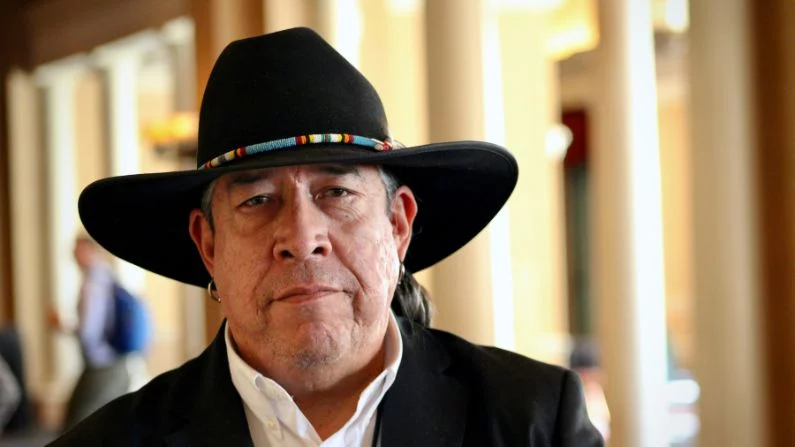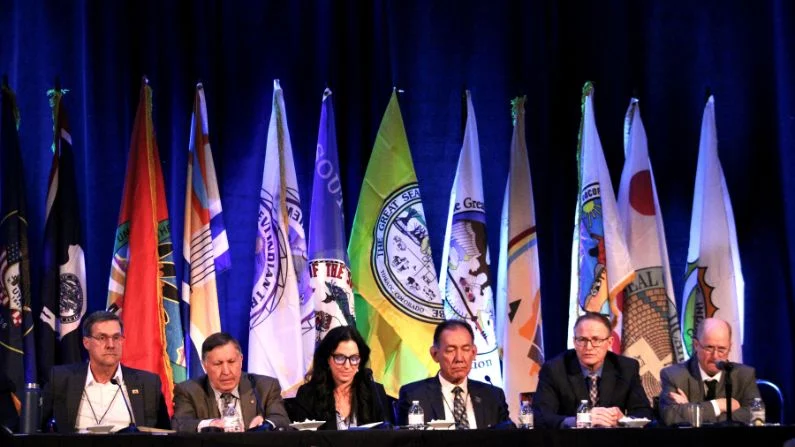The Colorado River is shrinking at the hands of climate change, and the people who decide its future are caught in a standoff over how to share its water. Putting them all in the same room, then, is bound to breed some tension.
The most powerful policymakers in the arid Southwest spent three days in Las Vegas, reviewing the grim state of a river that supplies 40 million people from Wyoming to Mexico.
Federal and state authorities emphasized the need for collaboration to avert catastrophe, but have been reticent to make sacrifices during negotiations over plans that would reduce demand for water.
This year marked the 76th meeting of the Colorado River Water Users Association and the event’s first ever sold-out attendance. Journalists, scientists, farmers and city officials packed the conference center at Caesar’s Palace to watch water managers hash out the river’s future in the public eye.

Farmers, journalists, academics, city officials and others gathered at Caesar’s Palace to hear policymakers chart the future of the Colorado River. (Alex Hager/KUNC)
“There’s no substitute for being face-to-face,” said John Entsminger, general manager of the Southern Nevada Water Authority, which supplies Las Vegas. “It’s a lot easier to talk a little smack, call some people some names, when you’re not looking them in the eye.”
Forecasts show the nation’s largest reservoirs dropping past already-historic lows, threatening the production of hydropower and the ability of water to pass through the nation’s largest dams. The seven states that use water from the Colorado River are scrambling to add to a patchwork of band-aid plans designed to stave off those immediate threats. At the same time, they are pondering a broader reworking of the existing guidelines that govern the river.
“We’ll probably come up with an imperfect alternative that gets us through the next few years as we continue to work on the longer-term, more durable solution,” Entsminger said.
The current guidelines for the river are set to expire in 2026, and states are largely focused on coming up with new ones before that deadline. A century-old agreement governs how water is allocated across the arid Southwest. Meanwhile, some experts suggest that agreement, the Colorado River Compact, should be replaced to meet the modern demands of a region with sprawling fields of crops and booming urban populations.
“I think there is some heavy optimism that hopefully everyone will come to something that we can all agree on,” said Becky Mitchell, director of the Colorado Water Conservation Board, the state’s top water policy agency. “But it is going to take real cuts to everyone.”
In past years, the annual Las Vegas Conference was the stage for the unveiling of landmark water conservation deals. This year, the Upper Colorado River Commission announced the revival of its conservation pilot program, but policymakers generally forwent the flashy press conferences of years past.
Bill Hasencamp, manager of Colorado River resources for the Metropolitan Water District of Southern California, said it felt inappropriate to engage in celebrations in the face of a “really dire situation.”
That same spirit, he said, was the reason basin states decided to nix plans for a traveling exhibit celebrating the 100-year anniversary of the Colorado River Compact in collaboration with the Smithsonian Museum.
Many state delegates to the water conference shifted focus toward the future and an upcoming Supplemental Environmental Impact Statement from the Biden administration. That statement could tweak river management rules drawn up in 2007, reducing the amount of water released from Lake Powell and Lake Mead, and forcing some states to deal with mandatory cuts in 2023 and 2024.
“Over the last several months, there has been a lot of silence,” Hasencamp said. “But at this conference, I do hear a renewed commitment to work together.”
The Bureau of Reclamation, which manages the region’s largest reservoirs and dams, is set to release a draft of the Supplemental Environmental Impact Statement in the spring, and is fielding alternatives from states until the end of January.
“We had a seven-state-only meeting and a commitment to have a process and a technical team really work through these issues and give it one try to come up with a consensus plan,” Hasencamp said. “That doesn’t mean it’s going to be easy, and it doesn’t mean we’re going to be successful. But at least there’s the effort to work hard over the next 45 days.”
Discussions before the end of that window, and before 2026, are likely to lay bare the tensions that define water use in the Colorado River Basin. The Upper Basin states — Colorado, Wyoming, Utah and New Mexico — are quick to point the finger at their Lower Basin counterparts. The Upper Basin argues that it has to carefully watch its water use, since its supplies are highly-variable, while the Lower Basin can consistently rely on a legally-mandated annual delivery that is the same size each year.
At the same time, tension abounds between cities and agriculture. Between 70-80% of water from the Colorado River is used on farms and ranches, and water policy analysts say that sector will have to take cuts if the region wants to keep taps flowing in urban areas that have grown by hundreds of thousands of people over the past few decades.
“We’re dealing with trying to respond to crisis, while also thinking about long-term sustainability planning for the basin,” said Elizabeth Koebele, an associate professor of political science at the University of Nevada, Reno. “And to me, that is creating so many challenges.”
Koebele, whose work focuses on environmental policy, said negotiations about the river’s future have been made tougher because there is no existing “coordination mechanism” to bring them together.
“I think people are still holding their cards pretty close,” Koebele said. “Even though we agree this is a problem and we need to do something about it, it’s not getting better, we haven’t yet agreed on who’s really responsible for doing any of that yet.”
As states work through the mire of negotiating amongst themselves, other groups that have historically been excluded from discussions about river allocation are asking for a seat at the table. Many of the 30 federally-recognized Indian tribes that use water from the Colorado River have called for greater inclusion of their interests, but feel that those calls are not being met.
“We want to have true and meaningful consultation,” said Shaun Chapoose, chairman of the Ute Indian Tribe of the Uintah and Ouray Reservation. “We want to really have nation-to-nation, but it really doesn’t exist. It sounds good in rooms, but what happens on the ground? For a person like me, who’s actually in that rumble, I always tell people, you’re seeing a narrative that’s not factual.”

Shaun Chapoose, chairman of the Ute Tribe, is one of many tribal members in the Colorado River basin who have asked for greater inclusion as the region negotiates how water will be allocated in the face of a shrinking supply. (Alex Hager/KUNC)
States have been public about their desire to include tribes in negotiations, but tribes themselves have said repeatedly that they are not seeing that manifest during times when states are crunched to pull together agreements.
Despite holding rights to about a quarter of the river’s flow, many tribes lack the funding and infrastructure to use their full allocations.
“It’s not so much me against you, it’s about resources,” Chapoose said. “I think as long as it’s not so much the bureaucrats running the show, but the water users themselves, tribes, individual owners, I think they’re going to all realize that really the system’s broke. So I think we’ll make our difference.”
Regardless of who is included, those who decide the future of the river are facing immense pressure to act quickly. Climate change is tightening its grip on the water supply, with a raft of major indicators showing a hotter, drier future for the region, and an urgent need to reduce demand in response.
This story is part of ongoing coverage of the Colorado River, produced by KUNC in Colorado and supported by the Walton Family Foundation. KUNC is solely responsible for its editorial coverage.






